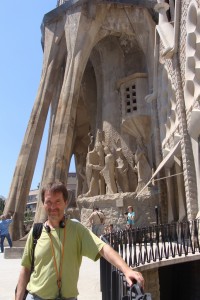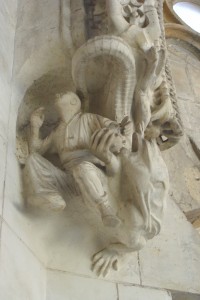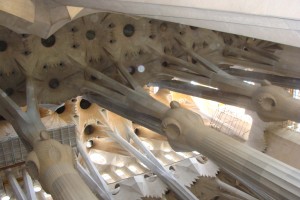In Part 1 of “The Fallen Traveller” a young man falls from a Barcelona work of art. In Part 2, Darcy and Alison visit Gaudi’s cathedral, where nothing is accidental.
2. Honeymoon and Cathedral
We had come to Spain, and in particular to Barcelona, on a kind of belated honeymoon. After ten years together, we thought it time to get away on our own. I sometimes work as a travel writer, but on this trip we were tourists, just two of the nearly one billion who travelled internationally for pleasure in 2010. With over 50 million visitors a year, Spain ranks as the world’s third most popular destination behind France and the United States. Spain, Barcelona and Parc Güell teem with tourists. To a traveller from rural Canada, these are the kinds of places that seem burdened with popularity.
We’d been planning this trip for an unusually long time, bought several guidebooks, researched on the internet, talked to friends. Foodies that we are, we’d even bought a coffee table book on Spanish cuisine. We understood – pleasure is planned. Landscape, food, wine, art, architecture, sunshine… each other – these were to be the sources.
On a foray into the Rioja region, we’d drink exquisite wine. On the Costa Brava, we’d swim in the Mediterranean and look back to the beach and the wild cliffs behind. We’d drive switchback roads through the Pyrenees and ride the cable car up to Montserrat. We’d walk the cobbled streets of medieval villages and stand quietly next to fountains in monastic cloisters. At his Theatre Museum in Figueres, we’d study Salvador Dali and his works. On Barcelona’s Las Ramblas we’d indulge in the excesses of consumer society, wining and dining our way along the strip.
Rioja region, we’d drink exquisite wine. On the Costa Brava, we’d swim in the Mediterranean and look back to the beach and the wild cliffs behind. We’d drive switchback roads through the Pyrenees and ride the cable car up to Montserrat. We’d walk the cobbled streets of medieval villages and stand quietly next to fountains in monastic cloisters. At his Theatre Museum in Figueres, we’d study Salvador Dali and his works. On Barcelona’s Las Ramblas we’d indulge in the excesses of consumer society, wining and dining our way along the strip.
We were no different than the other 50 million visitors to Spain. Instinctively we knew we’d find pleasures in the places that appeal to the senses or that imply history, original ideas, high ideals. For certain, we’d find beauty in Gaudi’s creations. In the end, by sharing these frequent moments of intense pleasure in the presence of beauty, we’d grow closer than is possible at home among the kids, the dirty dishes and the routine of daily life.
On our first morning in Spain, Alison asked, “So, what should we do first?” Without hesitation, I answered, “See Gaudi’s church.” At the Sagrada Familia, we planned to gaze skyward in awe of one man’s artistic and religious vision. And we did. We stood in the harsh heat humbled before the next great Catholic cathedral. It erupted a century ago from a single mind. In the Catalan language it’s the Temple Expiatori de la Sagrada Família or the Church of Atonement of the Sacred Family. Begun 125 years ago, it’s still under construction and will be for another seven to fifteen years, depending on the number of visitors who pay the twelve Euros to see it. On November 6, 2010, Pope Benedict XVI is scheduled consecrated the structure before a congregation of 6500.
The church is a monument as much to the great cycle of life, to the alpha and the omega, as it is to the holy family. Nothing about the church is accidental. Though at a distance it looks as if some giant hand dribbled wet sand into piles then splattered paint onto it, Gaudi designed La Sagrada Familia with great care. By modelling the interior columns after the branching structures of trees, he simultaneously strengthened the roof to bear the weight of its 18 reaching towers, eliminated the problem of flying buttresses which he called the crutches of Gothic churches, and spoke to the world about his reverence for nature and its place in Christian theology.
 Gaudi once said, “Those who base their works on the Laws of Nature collaborate with the creator.” Inside, the branching columns give the effect of looking into the canopy of a forest, glass domes lending the impression of penetrating sunlight. The view down the stairwells in the bell towers is like staring into nautilus shells. Forty species of animal are carved into the Nativity Façade, one of four entrances. Crowning the lush ornamentation at this entry, the tree of life rises skyward, white glazed ceramic doves fluttering among its branches. In contrast to the organic eruption of the Nativity Façade, the bleak Passion Façade opposite appears constructed of bone. The thin columns of extremely hard stone from nearby Montjuic reach into the street like a rib cage. Between 1986 and 2005, artist Josep Subirachs – true to Gaudi’s plans – depicted the Stations of the Cross in twelve plain, angular sculptures.
Gaudi once said, “Those who base their works on the Laws of Nature collaborate with the creator.” Inside, the branching columns give the effect of looking into the canopy of a forest, glass domes lending the impression of penetrating sunlight. The view down the stairwells in the bell towers is like staring into nautilus shells. Forty species of animal are carved into the Nativity Façade, one of four entrances. Crowning the lush ornamentation at this entry, the tree of life rises skyward, white glazed ceramic doves fluttering among its branches. In contrast to the organic eruption of the Nativity Façade, the bleak Passion Façade opposite appears constructed of bone. The thin columns of extremely hard stone from nearby Montjuic reach into the street like a rib cage. Between 1986 and 2005, artist Josep Subirachs – true to Gaudi’s plans – depicted the Stations of the Cross in twelve plain, angular sculptures.
That evening as we discussed the accident, trying to understand what it meant to us, to the victim, to his friends and his family, Alison said, “Think of why Gaudi built that church. The park was just for some rich bastard, but the church, it was for the people. Look how he built it – open on four sides so everyone can come in.” She was right of course. Gaudi himself said of his church that it would be “made by the people and is mirrored in them.” It was in this spirit, for example, that he designed a school on the construction site for the children of the workers.
“It was a place for them to go at times like this,” Alison said. “Send all your thoughts and energy to his family.”
“That’s not like you,” I said, and it wasn’t. Typically, Alison is dismissive of religion, has no time for talk of fantasies like positive energy, deities, the afterlife.
“If I were a religious person, I’d pray,” she concluded.
Continued from:
The Fallen Traveller, Part I – Gaudi and the Fall
Continues in:
The Fallen Traveller, Part 3: Following the Fall
The Fallen Traveller, Part 4: The New Life
The Fallen Traveller, Part 5: Writing the Story
Photo Credits
“Tree shaped columns inside Sagrada Familia” © Darcy Rhyno. All Rights Reserved.
“Darcy Rhyno at Sagrada Familia” © Alison Stanton. All Rights Reserved.
“Detail inside Sagrada Familia” © Darcy Rhyno. All Rights Reserved.



Fascinating read, Darcy. I can’t get your image out of my mind about the ‘fallen tourist’.
This is what I love about reading, feeling like I am right there with the writer. Thanks for this trip, Darcy, looking forward to the rest!